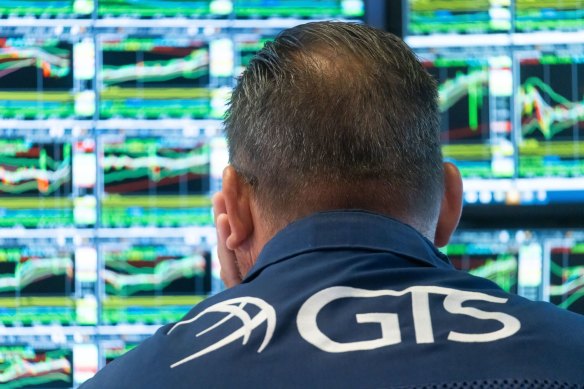
Nvidia, however, has forecast that it will generate $US37.5 billion of revenue in the December quarter, plus or minus 2 per cent. If it were to hit the central number, it would be slightly ahead of consensus expectations.
Blackwell appears to be a raging success, with Nvidia’s chief executive, Jensen Huang, saying demand for the chips was “insane”.
Indeed, demand for the chips appears to be substantially outstripping the ability of Nvidia and Taiwan Semiconductor Manufacturing Company’s (TSMC) ability to supply them, which augurs well for the first half of next year.
The company is surfing the boom in AI, with an estimated market share of more than 80 per cent for the chips that are powering it.
There is a scramble occurring among the biggest tech companies to grab their share of a market for what they expect to be transformational AI-facilitated technologies.
Loading
Between them, Amazon, Google’s parent Alphabet, Facebook’s parent Meta Platforms and Microsoft have lifted their capital expenditures by nearly 60 per cent so far this year, mainly because of their investments in AI. They are on track to spend more than $US240 billion this year – they are, as a group, spending more each quarter than they used to spend in a year before the AI arms race began.
While there are investors sceptical that the AI investments will produce returns in the near term that justify the scale of the investments being made, the companies see a generational opportunity. With the supply of chips constrained, that produces very fat margins for Nvidia.
Nvidia does have competitors – Microsoft, Intel, AMD, Amazon and Google are developing their own AI chips and there are hosts of smaller companies and start-ups scrambling to come up with their own products for advanced AI models – but Nvidia’s dominance, first-mover status and financial strength provide it with an opportunity to entrench its position.
Cash is pouring through its business – it has $US38.5 billion of cash or near cash in its balance sheet – even as new markets and applications for its ever more sophisticated chips are emerging rapidly.
The only constraints on the company are the lofty expectations of investors, where the maths for out-performance gets harder the larger Nvidia becomes; its ability to produce the chips to meet the demand and the US restrictions on sales of advanced chips to China.

Wall Street was treading water as it braced for Nvidia’s results.Credit: Bloomberg
The Biden administration has not only restricted China from buying advanced chips and chip manufacturing equipment from US suppliers but has also pressured its allies into doing the same.
The Dutch company, ASML, which manufacturers the state-of-the-art extreme ultraviolet lithography systems vital to make the most sophisticated chips, is unable to sell its latest generation of machines to China.
More recently, pressured by the Biden administration after its chips were found in a Huawei AI device, the world’s biggest chipmaker, TSMC, told its Chinese customers that it would no longer supply them with its most advanced AI chips. Any future sales are likely to be subject to a US approvals process.
China is the world’s biggest buyer of semiconductors and has set aside more than $US140 billion to develop its own chip-making industry, but the US sanctions have left it struggling to produce even the 7 nanometre chips that are several generations behind where the leading US companies now are.
The incoming Trump administration, steadily filling up with renowned China hawks, is unlikely to weaken its predecessor’s restrictions on chip exports to China or access to AI chip manufacturing technologies.
The only constraints on the company are the lofty expectations of investors, where the maths for out-performance gets harder the larger Nvidia becomes.
While the sanctions do shut off access to a potentially vast market for Nvidia’s most powerful AI chips, for the moment, given that it can’t meet the demand from other customers, that’s not yet a major threat to the company’s continuing growth.
Loading
Longer term, its dominance and the lucrative nature of the market for AI chips will continue to incentivise its own key customers and its competitors to pump capital into developing their own chips, while competition regulators might become more focused on the implications of its dominance.
The big tech companies will want to reduce their dependence on a single supplier (and the cost of developing their AI models) while competitors will want a share of the big profits and margins available from the AI chips that Nvidia’s earnings, as evidenced by its latest result, continue to highlight.
The Business Briefing newsletter delivers major stories, exclusive coverage and expert opinion. Sign up to get it every weekday morning.



























